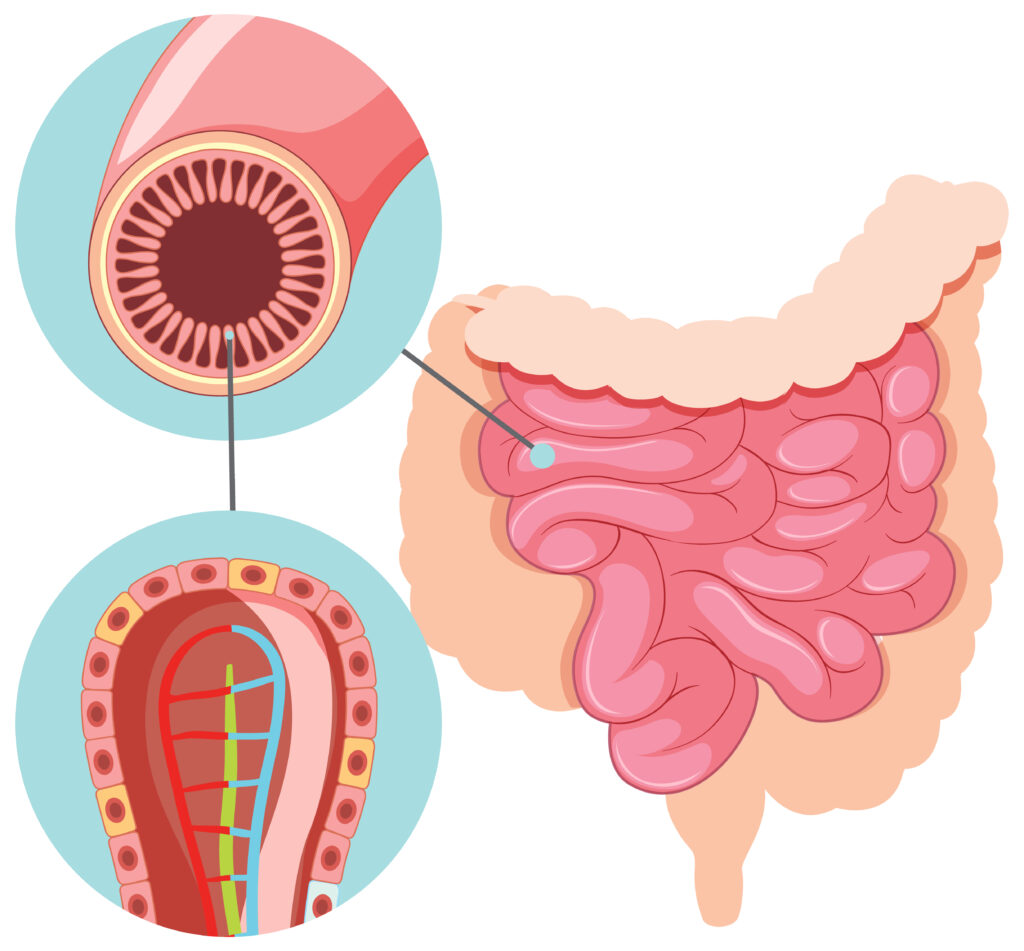Did you know that “May” is known as World Celiac Recognition Month? Celiac disease damages the small intestine as a result of an autoimmune disorder. Foods containing a protein called gluten, like grains like wheat, barley, and rye, cause Celiac disease. The Institute of Digestive, diabetes, and Kidney Diseases, reports that most people don’t know they have it but according to a survey, one out of 150 people in the USA, is affected by the Symptoms of Celiac disease.
Symptoms of Celiac disease affects people differently and can be difficult to diagnose. More than 200 known Celiac disease symptoms are observed which may occur in the digestive system or other parts of the body. Celiac disease may develop in childhood or adulthood. Some people do not show any symptoms at all but still test positive on the Celiac disease blood test. On the other hand, some may have a negative blood test but have a positive intestinal biopsy. However, Celiac disease puts you at risk for long-term complications, whether or not you display any symptoms. You might think Celiac disease is always diagnosed with symptoms like diarrhea and bloating but they vary widely from person to person. Medical professionals categorize Celiac disease into three distinct types jotted below.
Classical, Non-classical, and Silent Celiac Disease The World Gastroenterology Organization has divided the symptoms of Celiac disease into three types: Classical, Non-Classical and Salient Celiac Disease.
The World Gastroenterology Organization has divided the symptoms of Celiac disease into three types: Classical, Non-Classical and Salient Celiac Disease.
Classical Celiac Disease: People with classic Celiac disease have all the symptoms that you associate with the disorder, such as diarrhea, iron-deficiency anemia, and growth problems. Patients with symptoms of malabsorption, including diarrhea, steatorrhea (pale, foul-smelling, fatty stools), and weight loss have classical Celiac disease.
Non-Classical Celiac Disease: People with non-classical Celiac disease have symptoms that aren’t always specific to the disorder, such as chronic fatigue or continuous migraine attacks. Non-classic Celiac disease may not be triggered by any gastrointestinal symptoms at all. Patients with mild gastrointestinal symptoms, not showing clear signs of malabsorption, or may have seemingly unrelated symptoms may have non-classical celiac disease. Patients with non-classical celiac disease may suffer from abdominal distention and pain, and other symptoms such as iron-deficiency anemia, chronic fatigue, chronic migraine, peripheral neuropathy, chronic hypertransaminasemia, reduced bone mass and bone fractures, vitamin deficiency, difficulty in losing weight, early menopause and unexplained infertility, dental enamel defects, depression and anxiety, dermatitis itchy skin rash, etc.
Silent Celiac Disease: Silent celiac disease is also known as asymptomatic celiac disease and usually shows no symptoms of celiac disease, yet still present with lesions along the intestines, and points out the disease as a hallmark of the condition.
All types of Celiac diseases can lead to long-term health problems if left untreated.
Major Symptoms of Celiac Disease
1: Diarrhea
This is a specific problem for people with celiac disease. Diarrhea is a chronic disease with loose, watery stools. This symptom of celiac disease happens when the bowels have trouble absorbing liquids or excrete too much fluid. This malabsorption occurs when the lining of the intestine is damaged preventing proper absorption of nutrients. You might notice a few poop variations too, like pale in color, fattier, or even more foul-smelling than usual. This is the result of damage to the gastrointestinal tract. Some patients suffer from trouble passing stool, which leads us to the next symptom. In case of these types of symptoms, you can find relief with proper treatment and diet adjustments. Some more symptoms are linked with diarrhea but may be present, especially in children.
2: Constipation
Many people experience diarrhea as a symptom of celiac disease, but exceptional cases are also here with the symptom of constipation. Celiac disease deteriorates the cells of the inner lining of the intestines, and it causes extra moisture to be absorbed. Unusual absorption of liquid hardens the stool and causes constipation. Gluten-free diets are considered best to manage celiac are prone to cause constipation if care is not taken. So it must be in your notice to consume enough fiber when grains are cut out.
3: Abdominal Pain
When you experience celiac disease, abdominal discomfort is common. The exact mechanism of abdominal pain is still under discussion and unclear. One important point to ponder is, that the severity of symptoms does not correlate with the amount of internal damage from celiac.
4: Bloating or Gas
Bloating and gas are both caused by inflammation of the digestive tract. Even taking a small quantity of gluten can cause bloating if you are a patient with celiac disease. Celiac disease may lead to changes in the way food travels through the digestive tract if left untreated for a long time. A research study published in the Journal of Hepatology in 2023, clears that celiac disease can cause food to become backed up in the stomach, which may trigger bloating.
5: Anemia
An indicator that you have celiac disease is the deficiency of hemoglobin or iron deficiency called anemia. Celiac disease can make it harder for your body to absorb nutrients like iron from food and the body is unable to adequately absorb iron (along with other nutrients). Anemia causes fatigue, weakness, headaches, and dizziness. If you have iron-deficiency anemia, you may experience symptoms, including pale skin, fatigue, shortness of breath, and heart palpitations. The American Society of Hematology has published in their publications that some specific symptoms You might also notice, such as ringing in the ears, itchy skin, hair loss, and an intense desire to chew on ice.
6: Bone Loss
Celiac disease has also been diagnosed by the symptoms of osteoporosis and bone loss. Nutritional deficiencies of vitamins and minerals or malabsorption are the causes of bone loss while experiencing celiac disease but the direct link is still not known. Osteoporosis may occur if you experience a deficiency of vitamin D and calcium. In such a situation your small intestine is unable to absorb the required vitamins and minerals the way it’s supposed to, which leads to bones becoming weak, brittle, and more susceptible to breaking. Osteoporosis symptoms may include changes in your height and posture, and bone fractures.
7: Weight Loss
Sudden weight loss is the most obvious symptom of celiac disease. Due to damage in the intestine, the nutrients and calories may not be absorbed properly. This may result in unintentional weight loss. Gluten deteriorates the inner lining of the intestinal tract, thus your small intestine cannot absorb enough nutrients and your body has trouble absorbing nutrients from carbohydrates, fats, and proteins. Adopting a new diet halts weight loss but without enough calories, it can be difficult for people with celiac disease to gain or maintain weight.
8: Dental Problems
Celiac disease may cause dental problems such as discolored teeth, frequent cavities, and enamel erosion. These symptoms are observed in both children and adults. But while diagnosing celiac disease must be kept in mind that problems with gum health may also be a result of digestive disease.
9: Mouth Sores Mouth ulcers may be a symptom of celiac disease. The canker sores occur on the inside of the lips or cheeks and can take a week or more to heal.
Mouth ulcers may be a symptom of celiac disease. The canker sores occur on the inside of the lips or cheeks and can take a week or more to heal.
10: Headaches or Migraines
People who experience celiac disease may have been previously diagnosed with migraines or headaches.
Less Common Symptoms
11: Appearance of Super Itchy Rash
Some antibodies associated with celiac disease trigger an immune response in the skin and the rash appears. This rash continues to lessen with a sensation of inflammation and cause itching on your torso or limbs. Although fewer people experience this rash while fighting celiac disease, it is worse and more painful. This rash is not the result of any digestive issue but it’s an autoimmune disorder and can affect other body systems. The rash may also appear on your buttocks, knees, or elbows.
12: Chronic Fatigue
A feeling of exhaustion and tiredness is a specific symptom of celiac disease and manifests as chronic fatigue. Although the reason for this symptom is unknown, a study published in a genetics journal has revealed that inflammation from the autoimmune response is largely to blame. So If you’re feeling tired all the time or don’t have as much energy as you consumed, this may be a signs of celiac disease. The damage in the small intestine results in a lack of vitamin and mineral absorption that may lead to sleep disorders.
13: Weakness, Numbness, and Pain in Hands and Feet

Peripheral neuropathy happens when the nerves of your peripheral nervous system, the nerves outside your brain and spinal cord, become damaged. People with celiac disease suffer from nutritional deficiencies, including vitamins B6, B12, and E, and some minerals like copper impact the nervous system and lead to neuropathy. A few autoimmune disorders and antibody deficiencies can also cause uncomfortable sensations like numbness, pain, or tingling in the forelimbs and hind limbs.
14: Mood Changes
All symptoms of celiac disease are physical. Celiac disease also affects your mental state and triggers unusual mood swings. Irritability, anxiety, and depression are symptoms of mood changes due to celiac disease. Celiac disease makes it difficult for the body to absorb the nutrients necessary for brain health and living with a chronic illness can impact your mental health in general. People with chronic illnesses are at a higher risk of developing mental health conditions like depression and anxiety. Some people with celiac disease also report a kind of “brain fog” that can make it hard to think clearly.
15: Reproductive Issues
Nutritional deficiencies and an overactive immune system due to an untreated celiac disease, may lead to issues with your reproductive health. A study published in the famous journal of Gastroenterology has explained that changes in menstruation are common in people with celiac, including delayed, missed, or irregular periods, as well as changes in sperm health. The study also confirmed that pregnant women with untreated celiac disease may also be at greater risk for miscarriages, premature delivery, and birth of low weight babies, though more research is needed.
Symptoms in Children
Children show symptoms of celiac disease as soon as they start eating solid foods with glutes. They often show gastrointestinal symptoms like bloating, vomiting, constipation, diarrhea, and abdominal pain like adults but according to a study, children also experience other celiac disease symptoms that are not observed in adults. Take a look!
16: Growth Problems
Children with celiac disease sometimes are not mature enough to speak about symptoms. That’s why they aren’t diagnosed until they show sharp symptoms like delay in their expected growth schedule. The reason for their stunted growth may be the result of nutritional deficiencies and an overactive immune system. Therefore, children who are falling off their growth curves need to be screened for celiac disease regardless of the presence of gastrointestinal symptoms.
17: Delayed Puberty
Abnormal hormonal patterns trigger delayed puberty that may indicate celiac disease in older children and adolescents. This may be due to nutritional deficiencies or the autoimmune reaction occurring in the body.
18: Tooth Defects
Yes, it may be weird to know that celiac disease would have any impact on dental health, but children can indeed develop defects in tooth enamel. A few celiac disease symptoms are also diagnosed as discolored or translucent teeth and pitting or banding on the incisors and molars. This issue is also the result of malnutrition.
19: Behavioral Issues
Celiac disease can cause depression in younger children and they are more susceptible to problems with anxiety, oppositional defiance, and aggressive behavior. Pediatric researchers declare that behavioral changes in kids are due to nutritional deficiencies and changes in the gut-brain axis. This proves your emotions impact the digestive tract and vice versa.
Conclusion
Switching to a gluten-free diet to manage your celiac disease symptoms is a big burden on people and their families for many reasons. it is an expensive and complicated way to treat the disease. So people with celiac disease have to follow some simple steps to make the process a little easier. Focus on your diet and try to add meat and seafood, dairy, fruits and vegetables, beans, nuts, and seeds with some gluten-free edibles like bread. One more important tip, If you’re struggling to cope with celiac disease, don’t be ashamed to ask for help from your friends, your doctor, or a therapist. If you have symptoms of celiac disease, you should consult a Gastroenterologist. They will help you and recommend a treatment plan to manage your symptoms.







